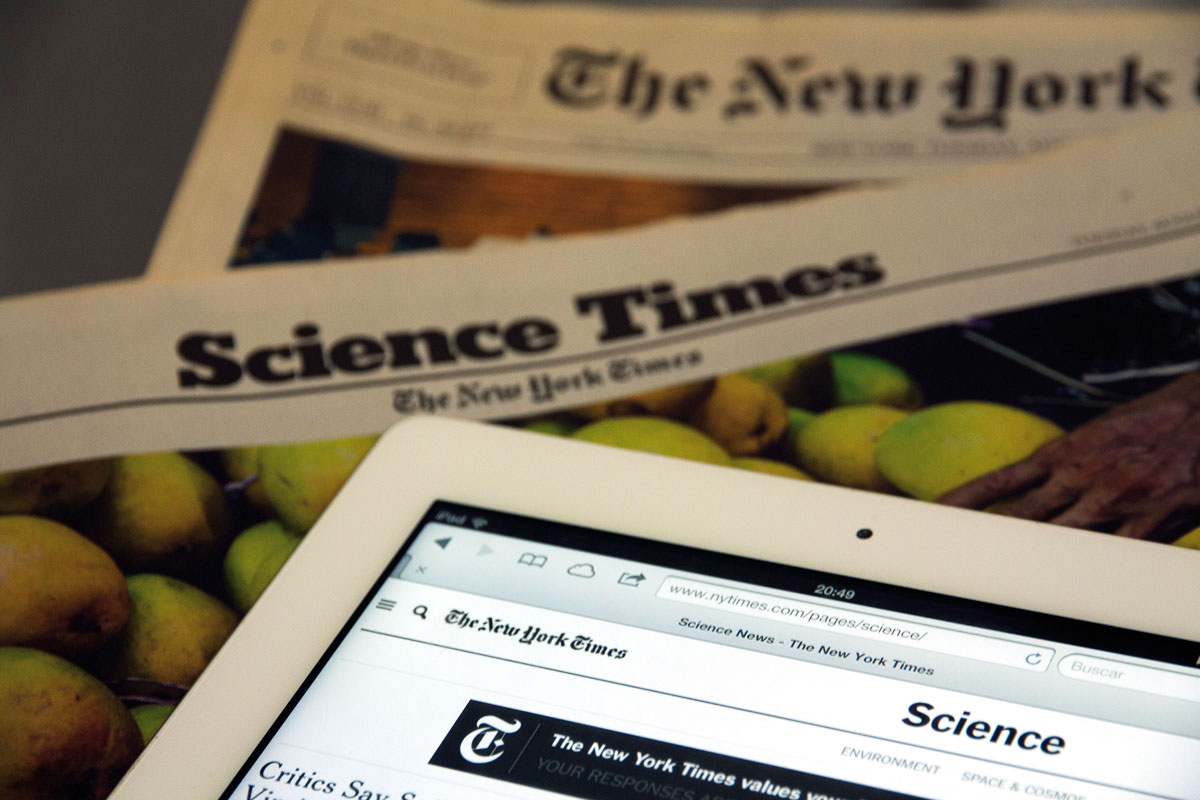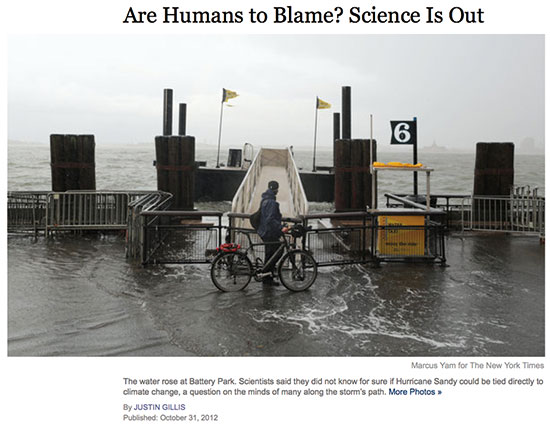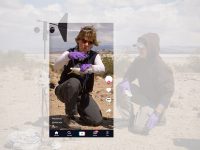A changing media landscape
Science, public and the press: the case of climate change

Economic restructuring in the media industry has eliminated many professional journalists’ jobs, reductions that may have been hardest on specialized journalists reporting areas like science, technology, economics, or international affairs. This makes audiences even more dependent on new, often social, media for scientific information. The concept of «critical science literacy» is introduced as a way to capture the skills needed to navigate science news in the evolving media landscape. While these same skills were needed to make sense of science in the «old» media world as well, the contemporary shift resulting in attenuation of authoritative journalistic voices is likely to continue, demanding more from audiences. Climate change illustrates these challenges.
Keywords: climate change, critical science literacy, new media, social media, specialized journalism.
THE NATURE OF SCIENCE COMMUNICATION
Communicating science has never been merely a matter of «translating» scientific facts into simpler language. While science is reported among scientists in the form of journal articles, which have a predictable structure including methods, data and results, science is reported to the rest of us in the form of journalistic stories, which also have a predictable but much different form. In journalism, method is abbreviated or eliminated altogether; rather, the point of the story is to explain the science in such a way that it not only makes sense to a non-scientist, but also so that person can see the relevance to his or her everyday life.
Of course, scientists are not always satisfied with this seemingly radical reconfiguration of their research, but scientific journal articles are not generally written in a way that makes them broadly accessible – not just accessible to non-scientists, but even to scientists whose work is in another area.
«Scientific journal articles are not generally written in a way that makes them broadly accessible, even to scientists whose work is in another area»
In recent history, much of this work of interpretation has been done by the group Dunwoody (1980) once called the «inner club» of science writing. Relying heavily on the concept of «objectivity» borrowed from science itself, early science writers regularly lacked formal training in science, although more recently it seems that a higher proportion have studied at least some science (Nelkin, 1995). More recently yet, an entire subfield called «science communication» has evolved – with it own degree programs, journals, and meetings, the very hallmarks of academic institutionalization within science itself.
Science communication is both a field of practice and a field of scholarly inquiry; it is both interdisciplinary and multidisciplinary (Priest, 2010). The major trend in the field in the last two or more decades has probably been its evolution from emphasizing the accurate communication of science to enhance public understanding and appreciation to the encouragement of active public engagement in science-related discussion, practice and decision-making, with the lofty (and laudable) goal of improving democracy itself. Both goals are important.
At the same time, with the emergence of the Internet and associated new communication technologies, information availability has exploded. The study of information seeking itself has become its own subfield; in practice, how exactly do we navigate this brave new world of seemingly infinite information? We can no longer rely on professional science writers to sort this out for us; in the current era of economic restructuring of the mass media, there seem to be fewer and fewer of them. While statistics on specialized jobs are hard to come by, a 2008 Pew survey of American news editors reported that three times as many US newspapers were allotting fewer resources for science reporting than were allotting more, compared to three years earlier (24% versus 8%; Pew Research, 2008). A report recently published by the Science and Development Network stated that only 28% of the science journalists they surveyed in the US and Canada were certain they would still be in the field in five years (Bauer et al., 2013: 29). While this statistic was based on a very small sample, it is consistent with the earlier Pew observations and with the American Society of News Editors’ report of a decline of almost one-third in US journalism jobs generally from 2000 to 2012 (Edmonds, 2013). The US Department of Labor (2014) projects a further 13% reduction in journalism jobs by 2022.
New forms of mediated communication have accompanied the arrival of the «information age». This means not only that the technology of communication has changed radically, but also that individual media consumers have enormous stocks of electronic materials to choose from, via the Internet. This is a tremendously rich and diverse collection of resources. What information anyone with an Internet connection and some experience with online searching can find with only a few minutes’ effort is astonishing. Of course, not all of it is equally credible – or equally comprehensible.
Audience members and writers alike need both science literacy and what I call «critical science literacy» skills. No differently than in the world of «old» media, both message construction and audience interpretation depend on both scientific knowledge and social values. They also depend on understanding the social and political organization of science, including such elements as the nature of scientific consensus. The big difference today is a broader array of messages and arguably less clarity on which ones to believe. Trust in the messenger has always been important; it has now become paramount, and with fewer reliable cues to define it.

Social networks offer the end user fewer explicit cues to credibility and accuracy than, «quality» or «elite» newspapers – in the United States, this often means The New York Times or The Washington Post. Above, the cover of both newspapers on 7 January, during the recent cold spell in the USA.
INSTITUTIONAL RESTRUCTURING AND NEW MEDIA
While this technology-based democratization of science has huge potential to help encourage popular awareness, engagement, even power, navigating the online world requires new skills. This does not mean only the skills to use the technology or to find the information, but the skills to evaluate, digest, integrate, and accept or reject material written for different audiences, with different purposes, and by individuals of every conceivable skill level and ideological perspective.
In the new media world, science news and commentary is regularly written for audience segments who share a particular perspective –whether pro-environment, pro-business, anti-GM, pro-GM, university-based, advocacy-based, government sponsored, completely «fringe», and so on. On the web we can find groups who are obsessed with the possibilities of solar flares or meteorite crashes; while these risks are real, they are often presented independent of contextualizing information about relative magnitude. We can even people concerned about the invasion of Earth by alien beings –and, of course, we find climate deniers and anti-vaccination groups whose positions are diametrically opposed to those advocated by the scientific and medical communities. This is an increasingly difficult landscape for unsuspecting non-scientists to negotiate, especially with fewer and fewer science-sensitive journalists to help.
It is the nature of science that an extreme, minority, or «maverick» opinion could, in the end, turn out to be right. However, this does not mean that every scientific idea is just as good as every other scientific idea. It is also the nature of science that it runs on consensus; it takes a certain weight of evidence to upset established, consensual scientific truth, as Thomas Kuhn famously pointed out. Understanding this aspect of the social character of science is essential to understanding the difference between truth supported by science and truth that is not supported by science, even though consensual scientific truth can turn out to be wrong (science always contains an element of uncertainty, in other words).
Ironically, while the Internet provides rich territory from which individuals can seek out whatever information (and interpretations) they like, new media forms are ever more dependent on information subsidies (Gandy 1982) and must work harder to capture audiences. Some will survive (or fail) as new types of for-profit news organizations in this increasingly competitive economic climate; others push out information for other reasons, whether personal, political, ideological, or institutional. News aggregators like yahoo.com now use the same sensationalistic techniques to attract audiences to science news that they use to attract them to entertainment news (Evans 2013). The old phrase «commodification of news» – referring to the treatment of news and information as a commodity to be bought and sold – has taken on new meaning.
«Most science news is written for specific audiences with some knowledge of scientific method and procedure. This can make it inaccessible to others»
Public relations interests have always provided much of the information that supports the creation of science news. What’s different now is that public relations and public information professionals are more directly utilizing – sometimes even creating – the new channels through which this news is received. For example, in 2009 a consortium of research universities in the English-speaking world launched a website called «Futurity», which distributes science news. Supported by the consortium, rather than advertisers, the site was created specifically to share science news directly to the public; this lofty goal means, however, that there is also no independent interpreter to facilitate wise public uptake. Science can easily be oversold in this environment.
THE «SOCIAL» IN SOCIAL MEDIA
In fully considering the implications of this change, we need to focus on the «social» dimensions of social media, as well as understanding the social dimensions of science itself. Social media generally refers to communication technologies that allow individuals to communicate in a two-way manner among members of a social network. Facebook and Twitter are examples of social media in this sense; blog posts, especially those inviting comments and thus are to some extent two-way media, are also social media in the sense their distribution may tend to follow pre-existing social networks and patterns of social identification and they are not, in the «old media» sense, truly «mass» communication aimed at or consumed by a broad general audience.
Social media are advantageous to those trying to get a message across to a very specific audience and this advantage is currently very popular with public relations specialists, but these channels offer the end user fewer explicit cues to credibility and accuracy than the «old media» journalistic outlets, which relied on journalistic reputation to establish these expectations. We read the Facebook posts of our friends, the Twitter messages of those we choose to «follow», and the blog posts of those we find entertaining. This is quite different from deciding to read a particular «quality» or «elite» newspaper – for example, in the United States, this often means the New York Times or the Washington Post – because that paper has a reputation for «quality» reporting.
One consequence of the social character of social media is that people may receive, or be attracted to, messages on the basis of the social networks to which they belong or the groups and ideas with which they identify. This may seem obvious but has the less-than-obvious consequence that they can more easily limit their exposure to viewpoints consistent with their own. Sometimes called «confirmation bias», this tendency is also relevant to the use of traditional media, but economic factors generally result in traditional media over-representing mainstream ideas. Media that operate for profit are constrained by the need to attract and hold significant audiences.
This constraint operates differently over the Internet, where space is effectively infinite and publishing costs minimal. The result is that in the world of social and other new media is arguably more fractionated than that of traditional media, and those seeking confirmation of extreme views can generally find it.

There is room for disagreement within science, but it is not true that one scientific truth is just as valuable as another. Not everyone with graduate training is an expert on all the science. We can find an example of this on the Global Warming Petition Project, in which the authors claim to have 31,000 American scientists who reject human causes of climate change.
CRITICAL SCIENCE LITERACY
Levels of science literacy in particular populations – even in the so-called developed world – are often low, a source of frustration in every nation that strives to advance its economy on the basis of its science and technology sector. This certainly does not mean that members of those populations are of lower underlying intelligence or incapable of understanding information about science. Multiple choice tests of science knowledge can underestimate the real intelligence or understanding of various audiences for science; these can assess only narrow factual knowledge, not broader understanding. However, most science news – in either the «old media» or the «new media» world – is written for specific audiences with some knowledge of scientific method and procedure. This can make it inaccessible to others.
This form of science literacy, involving a basic acquaintance with the vocabulary and methods of science, therefore remains important. In addition, however, another, often taken-for-granted, form of science literacy is needed that existing tests of scientific fact are not designed to measure. This is what I refer to as «critical» science literacy. Spelling out what it consists of helps emphasize the point that in the new media world, where old forms of journalism hold diminished sway, audiences need a lot of savvy to navigate the information territory.
Critical science literacy requires an understanding of the full range of scientific methods, not just experiments but also observation, description, theory-building and modeling. It requires an understanding of the meaning of scientific consensus, which is a social as well as a data-driven enterprise dependent (ideally, at least) on good-faith discourse and discussion in the forums of scientific meetings and the pages of scientific journals. It requires an understanding of the ideological and political motivations that sometimes underlie particular public positions on scientific issues, as well as of the nature and persistence of scientific uncertainty. It also requires fine distinctions in understanding expertise; a biologist does not necessarily understand geological processes, for example, an example inspired by Iben Browning’s 1990 prediction of an earthquake for New Madrid, Missouri.
We need this second form of science literacy more than ever in our contemporary world, as a quick look at the issue of climate change makes clear. While celebrating the new media world as providing vehicles for broader dissemination of scientific information and therefore further democratization of scientific policy, it has something of a dark side well illustrated by climate change.
CLIMATE CHANGE: A SCIENCE COMMUNICATION EMERGENCY
The specific case of climate change, which many conceptualize as a sort of science communication emergency as well as a global environmental emergency, makes this constellation of issues more concrete. Why people are divided over the existence of climate change, as well as what to do about it, despite many sincere efforts to educate them has been widely regarded among scientists as a puzzle, a mystery of sorts. Science communication scholars know that better understanding of the science itself – basic science literacy – is not an adequate answer to many such puzzles, but this does not fully explain how this particular area of climate science has become so hotly contested. However, if we consider the convergence of the factors discussed above and how they apply to this case, it is relatively easy to understand why the scientific reality of climate change is not universally accepted.
«While celebrating the new media world as vehicled for information and democratization, it has something of a dark side well illustrated by climate change»
First of all, it is prima facie difficult to accept that the nurturing Earth we have known might not nurture our grandchildren in the same way – that reality as we know it may be slipping away with every melting iceberg and glacier. This challenges our common sense ideas about the world we live in and presents as disturbing a picture as surely as if we were to observe the sun suddenly to start rising in the West and setting in the East. Yet unlike this imagined change in the sun’s movement across our sky, climate change is not always immediately visible as we go about our demanding daily schedules; on the contrary, it is very easy to avoid. If we stick to information sources that do not insist we confront it, it is easy to pretend it does not exist. If we live surrounded by a social environment that does not expect us to accept it, this is easier yet.
Climate change is also the perfect example of the skills needed to navigate competing scientific claims. Uncertainty about its nature, rapidity, and specific ultimate effects invites both journalists and audiences to perceive uncertainty in the underlying consensus that it exists. The opinions and pronouncements of all apparent experts tend to be treated as interchangeable, obscuring the consensus that exists among climate scientists. On the other hand, isolated studies that seem to indicate that counter-claims and opposing trends have strong bases in the empirical record are understood as scientific fact. The ideological and political purposes that are intertwined with climate change denial are not visible to many.
Journalists cannot magically imbue their audiences with the knowledge and awareness necessary to navigate this complexity, but we can think about these challenges in constructing our stories. Just as science-and-society scholars urge the scientific community to be reflexively conscious of the impact of science on society, we can be reflexively conscious of the impact of science journalism on society. In the case of climate change, as well as other science reporting, there are some very specific things that journalists – as well as audience members – might keep in mind.
Contextualize Both Disagreement and Uncertainty
Did the enormous scale and damage from Hurricane Sandy have anything to do with climate change?… [Climate scientists] simply do not know for sure…
(Gillis, 2012)

It is the nature of science that many conclusions reflect probabilities rather than certainties and that equally qualified experts can disagree. Sometimes these realities of science are not taken into account, as in this article published in The New York Times (Gillis, 2012).
The first time I observed a Weather Channel online commentator admit that strange weather (such as an unusually strong storm) might reflect a changing climate, it was almost funny. The part he was having trouble with seemed to be the probabilistic nature of the relationship. As a broadcaster, he was clearly more accustomed to working with less slippery, more black-and-white facts that did not require such careful qualification. It is the nature of science that many conclusions reflect probabilities rather than certainties. It is also the nature of science that equally qualified experts can disagree, and that most results are subject to interpretation and revision as new evidence accumulates. Yet this does not mean that scientists are less than certain that (for example) climate change exists. Our best evidence right now very clearly indicates that it does, and most appropriately credentialed scientists support this view.
Appropriately Represent Expertise: All Ph.D. Degrees Are not Alike
31,487 American scientists have signed this petition [rejecting the scientific evidence on the impact of greenhouse gases], including 9,029 with PhDs.
(Global Warming Petition Project, 2013)
It is difficult to speculate on how much of the «pseudo-science» being disseminated by climate deniers is a deliberate attempt to mislead and how much springs from simple ignorance; part of critical science literacy is the recognition that both of these things are possible, and yet (even though there is room for disagreement within science) it is not true that one scientific truth is just as valuable as another. Political journalism often pits «left» against «right»; the result is considered a «balanced» and therefore «objective» story. But in science, there are some elements about which equally qualified experts may hold different opinions and other elements where there is a clear consensus among subject specialists. It is not always easy to tell the difference, but it is appropriate to ask whether the source in question really qualifies as a subject specialist. Not everyone with graduate training is an expert on all the science.
Reflect consensus appropriately; don’t stress individual «maverick» studies
The world stopped getting warmer almost 16 years ago, according to new data released last week..
(Rose, 2012)
Even in those areas where there is strong consensus among subject specialists, studies can and will emerge that contradict mainstream thinking. This is the very nature of science, and the last thing scientists should seek is the suppression of dissenting results. Otherwise we would still believe that the world was flat and the Earth was the center of the universe. At the same time, a single maverick study (or even several of them) does not mean that a particular scientific consensus is necessarily wrong. Major shifts in the scientific consensus require the accumulation of a huge preponderance of evidence. It is just this kind of preponderance that has convinced climate scientists that climate change is a reality. It would – and should – require an equally strong preponderance to reject this conclusion. Part of contextualizing disagreement should involve cautious reporting of so-called «maverick» results.
Think about appropriate terminology
There have long been claims that some unspecified «they» has «changed the name from “global warming” to “climate change”».
(Wayne, 2013)
«Climate change is very easy to avoid. If we stick to information sources that do not insist we confront it, it is easy to pretend it does not exist»
Sometimes journalists are given the advice to use the term climate change instead of global warming. While they may mean different things scientifically, this advice does seem to have been intended strategically. On any given day some people might experience unusual cold rather than warmth. It may also be that «climate change» seems more neutral and therefore more «scientific». Another common piece of advice is to distinguish climate from weather. While the difference is scientifically important, most people experience climate as weather. So, on the one hand, every especially cold or snowy day does not mean that the globe is cooling rather than warming. On the other, patterns of unusual weather can signal a changing climate, and the globe is indeed warming. There is nothing particularly wrong with saying so, even though we should choose our terminology with care – and with conscious regard of how it might be interpreted.
Much as we should celebrate the opportunity provided by a rich and diverse new media environment to accommodate alternative and dissenting voices, along with this has come the disappearance of an informed and authoritative interpretation – a journalistic consensus, if you will – that once helped unify our thinking about the nature of scientific consensus. Without critical science literacy of our own and without being aware of the need for it in the audiences for science, we may not successfully navigate or communicate a completely open market of scientific ideas. While I personally believe that people are smart and will eventually ferret out the truth, in the present climate emergency and without these skills, they may not do so quickly enough. Yet the future, to a very significant extent, depends on our ability to do so.
Referencies
Bauer, M. W.; Howard, S.; Romo Ramos, Y. J.; Massarani, L. and L. Amorim, 2013. Global Science Journalism Report. SciDevNet. London.
Dunwoody, S., 1980. «The Science Writing Inner Club: A Communication Link Between Science and the Lay Public». Science, Technology, & Human Values, 5(30): 14-22.
Edmonds, R., 2013. «ASNE Census Finds 2,600 Newsroom Jobs Were Lost in 2012». Poynter.org, 26 June.
Evans, W., 2013. «Attracting Audiences to Science News: Ethical and Moral Considerations». Workshop on the Ethics of Science Communication, May. University of Iowa. Iowa.
Gandy, O. C., 1982. Beyond Agenda Setting: Information Subsidies and Public Policy. Ablex. Norwood.
Gillis, J., 2012. «Are Humans to Blame? Science Is Out». The New York Times, 31 October. Accessed online on August 3, 2013.
Global Warming Petition Project, 2013. Accessed online on August 3, 2013.
Nelkin, D., 1995. Selling Science: How the Press Covers Science and Technology. 2nd edition. W. H. Freeman. New York.
Pew Research Center, 2008. «Changing Content». Pew Research Journalism Project.
Priest, S., 2010. «Coming of Age in the Academy? The Status of Our Emerging Field». Journal of Science Communication, 9(3).
Rose, D., 2012. «Global Warming Stopped 16 Years Ago, Reveals Met Office Report Quietly Released… and Here Is the Chart to Prove It». Mail Online, 13 October. Accessed online on August 3, 2013.
US Department of Labor, 2014. «Occupational Outlook Handbook, Entry for "Reporters, Correspondents, and Broadcast News Analysts"». 8 January. In Bureau of Labor Statistics. US Department of Labor. Washington.
Wayne, G. P., 2013. «Global Warming vs. Climate Change». Skeptical Science: Getting Skeptical About Global Warming Skepticism. Accessed online on August 3, 2013.





